

 The South African
The South African
Major Darrell D Hall
Major Darrell Hall comes of distinguished military ancestry on both sides. His father served in Botha's Natal Horse 1914-1915 and his grandfather was a transport conductor in the Zulu War of 1879, serving with the central column and subsequently with Pearson's Column. An ancestor on the distaff side served in Bowker's Rovers in the Gaika-Galeka War.
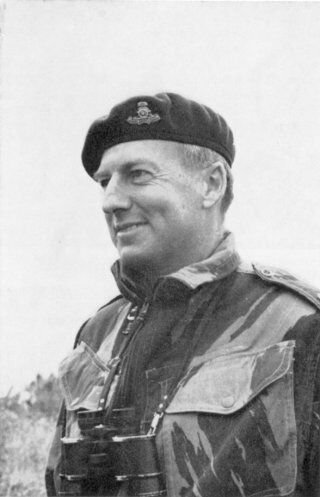
Major Darrel Hall
Major Hall joined the British Army in 1946 after an education at Michaelhouse, and retired in 1968. He saw service in the U.K., Germany, Norway, North Africa, Cyprus and the Far East. He qualified as a paratrooper and served with the Parachute Brigade and later with the Royal Marine Commando Brigade. He took part in the Anglo-French invasion of Egypt and served as commander of Kirkee Light Commando Battery in the Borneo confrontation of Indonesia and Malaysia. Since his retirement Major Hall has been in business in Durban where he is an active member of the Society's Durban Branch.
This was an interesting period in the development of Artillery. It marked the change-over from muzzle-loading short range guns with no recoil arrangements, and only rudimentary sighting systems, to the more sophisticated long range, breech-loading, quick-firing, recoiling guns of the 20th Century.
This development forced the pace in Artillery tactics and handling. The importance of communications, observation of fire methods, and concealed gun positions soon became apparent. The enemy no longer stood out in the open, and Artillery tactics were soon shown to be in need of review. These articles, however, will only cover the equipments. Artillery tactics will be dealt with separately.
Details of the equipments vary from source to source. Care has been taken to provide figures which are as accurate as possible, but it should be remembered that even these are only a guide to performance in the field.
Weather conditions, particularly wind and air temperature, will affect the range of a gun. Firing from the top of a hill, as did the Boers on many occasions, will give a greater range than when gun and target are on the same level. A gun will fire further at five or six thousand feet above sea level than at sea level. All these factors will affect fuze setting. This may explain why Boer fuze setting was poor.
Maps were poor or non-existent. Estimates of ranges in narratives of the war may often be inaccurate, resulting in a gun being credited with a greater range than was justified.
Finally, the guns themselves could be coaxed into firing further than the range for which they were designed. The Naval 'Long 12s' (12 pr 12 cwt) on more than one occasion had their trails dug in to provide greater elevation; or had them blocked completely to prevent any recoil and so give a longer range, although this would damage the axle and/or trail. The Boers were known to put an additional half-charge into captured 15 prs to get greater ranges.
Nearly 30 guns and howitzers will be described in these articles. It may be of assistance to mention the more important equipments used by both sides in the war.
At the outset, with the British Army were:
| Royal Horse Artillery | 12 pr 6 cwt BL |
| Royal Field Artillery | 15 pr 7 cwt BL 5 in Howitzer BL |
| Royal Garrison Artillery | 2.5 in RML |
Initially there was an absence of long range Artillery, and this gap
was filled by the Royal Navy. Guns were removed from ships, given temporary
carriages, and sent to the front with Naval detachments. These were:
12 pr 12 cwt QF ('Long 12')
4.7 in QF
6 in BL
Later the Royal Garrison Artillery appeared on the scene, and took over
these guns to allow the sailors to return to their ships. In addition,
they brought with them the following:
5 in BL
6 in Howitzer BL
Boer Artillery was a mixture of obsolete guns and the latest that Europe
had to offer. Most prominent among the latter were:
75 mm Creusot QF
75 mm Krupp QF
120 mm Krupp Howitzer QE
155 mm Creusot BL ('Long Tom')
37 mm Maxim Automatic Machine Gun ('Pom-Pom')
This review will be in six parts, arranged as follows:
Part 1-British Field and Horse Artillery (this issue)
Part 2-British Mountain and Light Artillery (this issue)
Part 3-Boer Artillery
Part 4-Guns of the Royal Navy
Part 5-British Siege Artillery and Artillery of Position
Part 6-Miscellaneous.
Outranged by Boer artillery in the opening stages of the war, British artillery in the field was initially at a distinct disadvantage. This was overcome to a certain extent by the massing of artillery fire in comparison with the Boers, and by bold handling, although on occasion the methods used were foolhardy. Guns in this category were:
12 pr 6 cwt BL
15 pr 7 cwt
5 in Howitzer BL
These three were the main armament of the artillery in the field.
12 pr 12 cwt QF
12.5 pr Vickers Maxim QF
These guns were in limited numbers only.
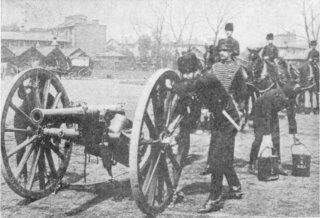
12 pr 6 cwt BL - note
the drag shoes under the wheels.
12 PR 6 CWT BL ON MK I CARRIAGE
| Calibre | 3 in |
| Weight of gun | 6 cwt |
| Weight of gun carriage packed | 17 cwt 3 qtrs 20 lbs. |
| Weight behind gun team | 32 cwt 3 qtrs 20 lbs |
| Ammunition | Shrapnel |
| Weight of shell | 12 lbs 8 ozs |
| Range: Time-Fuze | 3,700 yds |
| Range: Percussion | 5,400 yds |
| Rate of fire | 7-8 rpm |
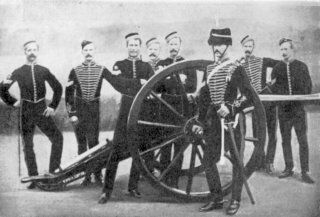
12 pr - this may well be
the earlier 12 pr 7 cwt BL.
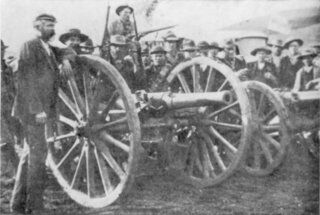
12 pr 6 cwt BL - one of the guns
captured at Koorn Spruit.
It proved to be too heavy for the RHA and a new 12 pr gun of 6 cwt, with a simple, light carriage, was introduced in 1894. This constituted the armament of RHA batteries when the Army took the field in 1899, except for batteries from India which had the 15 pr. All 12 prs in South Africa were on Mk I carriages. The detachment was completely mounted, where RFA detachments rode on limbers, and sometime on guns.
Only shrapnel was provided. The maximum time-fuze range was the maximum effective range, as a shrapnel shell bursting on percussion was not of much value. The range quoted in the table is with Fuze 56. Later the new Fuze 57, known as 'The Blue Fuze' from the colour it was painted, produced a greater time-fuze range. Filled with a slower burning composition, it was effective up to 5,800 yds.
15 PR 7 CWT BL ON MK I CARRIAGE:
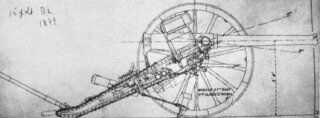
15 pr 7 cwt BL on Mk III carriage -
the operation of the axle spade
is clearly illustrated here.
| Calibre | 3 in |
| Weight of gun | 7 cwt |
| Weight of gun carriage packed | 20 cwt 2 qtr 27 lbs. |
| Weight behind gun team | 37 cwt 2 qtrs 17 lbs |
| Ammunition | Shrapnel |
| Weight of shell | 14 lbs 1 oz |
| Range: Time-Fuze | 4,100 yds |
| Range: Percussion | 5,600 yds |
| Rate of fire | 7-8 rpm |
Experience had shown that the 12 pr 7 cwt shell had little effect on earthworks.
It was, therefore, converted to a 15 pr (although the shell in fact only
weighed just over 14 lbs). In 1895, this became the gun of the RFA. This
conversion was possible as the new smokeless propellant, Cordite, was much
more powerful than gunpowder. It provided an opportunity for adding to
the weight of the shell without necessitating any major alterations to
the gun.
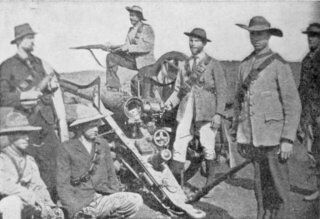
15 pr 7 cwt BL on Mk III carriage -
note the tangent sight mounted above
the breech, and the elevating screw.
This method of elevation had been in use for over 200 years.
At the same time, the cry of 'one shell, one fuze' resulted in the 15 pr only receiving the shrapnel shell. The shortburning time-fuze was a major disadvantage in South Africa. Being frequently outranged by Boer artillery, there were many instances where RFA had to move forward under fire in order to be able to engage the enemy with air-burst shrapnel. Later, the new 'Blue Fuze' (Fuze 57) increased this range to 5,900 yds.
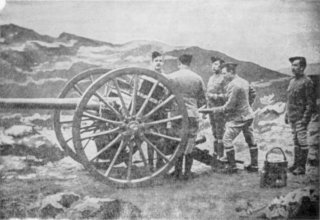
15 pr 7 cwt BL -
axletree seats are
evident in this
and Figure 5.
The 15 pr was also notable for the axle-spade system of controlling carriage recoil. The spade was connected by a rope stay to a strong spring in the trail. The recoil of the carriage caused the spade to dig into the ground, and the stay then prevented any movement of the carriage except that permitted by the compression of the spring. This spring housing was a distinctive feature of the 15 pr. However, batteries arriving from India had not yet had this modification applied to their guns.
The majority of batteries had the Mk I carriage; four had Mk II and three Mk III carriages.
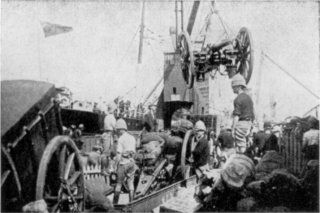
15 pr 7 cwt BL - these are guns of 21
Battery RFA arriving in Durban from
India.
Axle spades and trail springs had not been
fitted to guns arriving from that country.
This Battery served in Ladysmith during the siege.
5 IN HOWITZER BL ON MK II CARRIAGE:
| Calibre | 5 in |
| Weight of gun | 9 cwt |
| Weight behind gun team | 48 cwt 1 qtr 26 lbs |
| Ammunition | Common shell |
| Weight of shell | 50 lbs |
| Range | 4,900 yds |
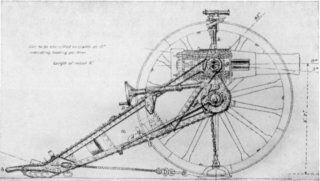
5-inch Howitzer BL -
the trunnion gearing elevation system
and the method of fitting
drag shoes can be seen here.
The abolition of common shell for field guns brought to a head the demand
for some form of artillery which would give greater shell power in the
field. The attempt to employ guns for curved fire by the use of reduced
charges failed, and consequently the need was met by the formation of field
howitzer batteries. The first was organized in 1896 and was armed with
this equipment. At about the same time, a 6 in Howitzer was introduced
for use with the Siege Train.
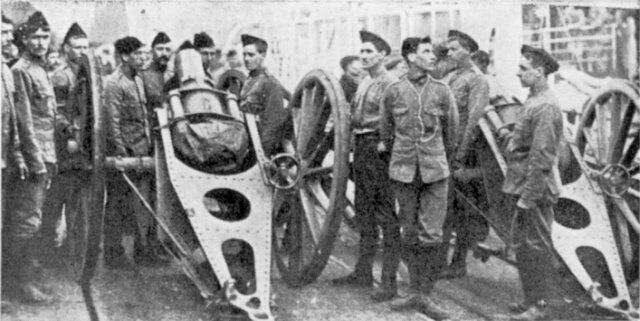
5-inch Howitzer BL - the short,
stubby Howitzer barrel is distinctive.
The recoil system should be noted.
Stays from the axle to the trail
help absorb the shock of firing.
The 5 in Howitzer was first used in the Sudan in 1898. Lyddite was introduced as the new bursting charge with this howitzer, but it was greatly overrated. There were exaggerated press reports that the mere concussion of the explosion was enough to kill any enemy in the vicinity. Too much was expected of it in South Africa where, in addition, it was found that the Lyddite often failed to detonate. However, some success was achieved in Natal, when the 5 in Howitzer was able to get close and engage targets such as Boers in trenches. As a field howitzer it was found to be too heavy. The shell was too light and the range too short; but it did have some interesting features.
A recoil system was incorporated. This allowed a short recoil of six inches only, so it was also necessary to fit drag shoes. (The French were the first to adopt the theory of 'long recoil', which, coupled with an adequate recuperator to return the gun to its original position, allowed quicker laying and real 'Quick firing').
Elevation was by trunnion gearing. A crank was fitted to the right trunnion. This was operated by a long screw and nut turned by the elevation handwheel.
Muzzle velocity was from 402 to 782 feet per second (depending on charge) compared with the 15 pr's 1,574 feet per second, illustrating one of the differences between a howitzer and a gun.
12 PR 12 CWT QF:
| Calibre | 3 in |
| Weight of gun | 12 cwt |
| Weight of gun carriage packed | 30 cwt 0 qtrs 3 lbs |
| Weight behind gun team | 44 cwt |
| Ammunition | Common shell and shrapnel |
| Weight of shell | 12 lbs 8 ozs |
| Range: Time-Fuze | 4,200 yds |
| Range: Percussion (Shrapnel) | 6,500 yds |
| Range: Percussion (Common) | 8,000 yds |
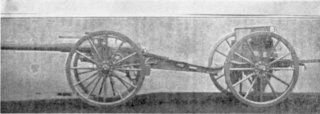
12 pr 12 cwt QF -
this was the Naval
'Long 12' on a field carriage.
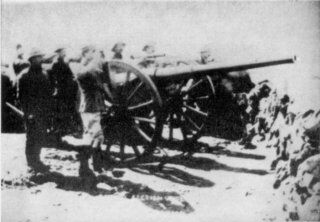
12 pr 12 cwt QF -
an 'Elswick gun' in South Africa.
This was the gun of the Elswick Battery (see 'The Elswick Guns', by Major L. A. Crook, in Volume 1, No.4 of this journal). It was basically the Naval 'Long 12' which will be described later in this series. Removed from a Japanese battleship under construction at Armstrong Whitworth Ltd., six 12 pr 3 in guns were converted to field pieces at the Elswick Ordnance Works at Newcastle-upon-Tyne. They were presented to Lord Roberts by Lady Meux, and went to South Africa manned by the men who made them. These guns had a high muzzle velocity (2,210 ft per sec with common shell) and a long range, but were too heavy for Field Artillery and not powerful enough for Heavy Artillery.
12 1/2 PR VICKERS MAXIM QF:
| Calibre | 2.95 in/75 mm |
| Weight of gun | 6 cwt |
| Weight of gun carriage packed | 20 cwt 2 qtrs 20 lbs |
| Weight behind gun team | 38 cwt 1 qtr 20 lbs |
| Ammunition | Shrapnel |
| Weight of shell | 12 lbs 8 ozs |
| Range: Time-Fuze | 5,200 yds |
| Range: Percussion | 6,000 yds |
The City Imperial Volunteer Battery was equipped with this gun. It had
four 124 prs. The only other 124 pr with the British Army, was with Colonel
Plumer. This was one of the two guns purchased by Dr Jameson for his raid.
It had, however, been left behind in Bulawayo on that occasion, owing to
the non-arrival of its carriage. It thus escaped the fate of its sister
gun which was captured by the Boers at Doornkop in 1896. The two guns met
again on opposite sides in the Metse Mashoane Valley in February 1900,
when von Dalwig had one of them, and Plumer the other.

12 1/2 pr Vickers Maxim QF -
the gun of the CIV Battery.
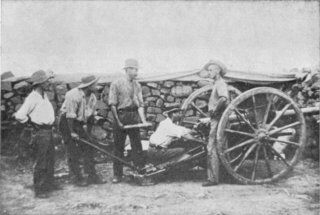
12 1/2 pr Vickers Maxim QF -
this is the lone 12 1/2 pr
with Plumer's Column.
Firing light shells a short distance only, these guns did not achieve much
success in the war. However, in spite of their obsolescence, they were
needed in the opening stages. Screw guns helped defend Kimberley; and all
saw service in the early battles in Natal.
Guns in this category were:
2.5 in RML Mk II ('Screw Gun') This was the gun of Mountain
Artillery.
3 pr Hotchkiss BL
7 pr RML Steel Gun Mk IV 200 lbs
7 pr RML Steel Gun Mk IV 200 lbs on Field Carriage
2.5 in RML on Field Carriage
9 pr RML 8 cwt
These guns were with locally raised Colonial Forces.
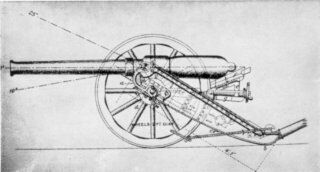
2,5 inch RML ('Screw Gun') -
the quoin method of elevation
was the oldest known, and was used
up to the end of the 19th century.
The check rope provided the only means
of controlling recoil with this equipment.
2.5 IN RML MK II ('SCREW GUN'):
| Calibre | 2.5 in |
| Weight of gun | 400 lbs |
| Weight of gun carriage and gun | 800 lbs |
| Ammunition | Ring, Shrapnel, Star and Case |
| Weight of shell: Ring | 8 lbs 2 ozs |
| Weight of shell:Shrapnel | 7 lbs 6 ozs |
| Range: Ring | 4,000 yds |
| Range: Shrapnel | 3,300 yds |
This gun was adopted in 1879 to meet a demand for greater power for Mountain
Artillery. As it was too heavy for a single mule load, weighing 400 lbs,
the gun was jointed at the trunnions and could be broken down to two loads;
hence the name, the 'Screw Gun'. The gun carriage and wheels were carried
on another two mules.
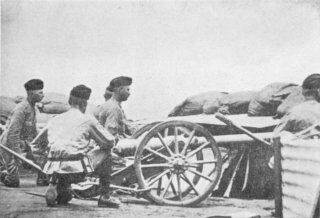
2,5 inch RML - the Screw Gun
in the Defence of Kimberley.
It fired a black powder charge which caused a large cloud of smoke. This was disastrous in South Africa. It had a flat trajectory. To engage a target at the same height at its maximum range of 4,000 yds, required an elevation of only 11deg 7min. The request for a howitzer for Mountain Artillery was only granted in 1918.
Mountain gunnery was the responsibility of Companies of the Royal Garrison Artillery.
3 PR HOTCHKISS BL:
| Weight of shell | 3 lbs |
| Range | 3,500 yds approx. |
The Natal Volunteer Hotchkiss Detachment had two of these 3 pr Hotchkiss guns and one 9 pr. Although not of much value, these Hotchkiss guns helped defend Ladysmith.
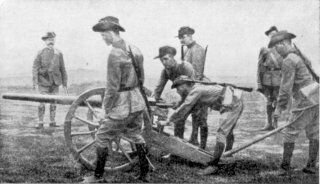
3 pr Hotchkiss BL -
Walker's Maritzburg Battery.
7 PR RML STEEL GUN MK IV 200 LBS ON MOUNTAIN CARRIAGE:
| Calibre | 3 in |
| Weight of gun | 200 lbs |
| Ammunition | Common, Shrapnel and Double |
| Weight of shell: Common | 7.4 lbs |
| Weight of shell:Double | 12 lbs |
| Range: Common | 3,100 yds |
This was a Mountain gun, the predecessor of the 'Screw Gun'. It could be assembled and a round loaded in 20 seconds. Its Common shell was not very effective. In India it was said to stick in a mud wall at 450 yds, and would rebound from a stockade to explode on the ground.
To give it a high angle capability, a Double shell was produced. This was of increased length and contained a bursting charge larger than that used with ordinary shell. It was fired with a reduced charge, but the low muzzle velocity did not always arm the fuze, or prevent the over-long projectile from somersaulting.
Shell rotation in each case was effected by studs on the body of the shell. Elevation was by quoin or wedge and by screw.

7 pr RML on Mountain carriage -
this drawing shows the three alternative positions for the quoin,
the lowest providing the greatest elevation. Fine adjustment was
achieved by screwing the quoin in or out as required.
The gun was mounted on armoured trains, and was used by locally raised forces in the early stages of the war.
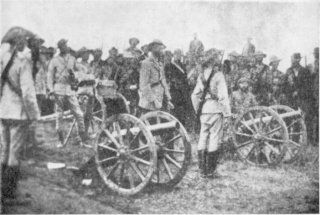
7 pr RML on Mountain carriage -
these guns were captured at Kraaipan.
7 PR RML STEEL GUN MK IV 200 LBS ON FIELD CARRIAGE:
Specifications .. .. .. As above
This was the same gun mounted on a Field carriage. This gave it greater manoeuvrability, enabling it to be horsedrawn. The increased height of the gun above the ground led to easier operation, particularly in long grass. The firmer platform may also have produced a slightly greater range. However, the light shell and short range, compared with Boer guns, reduced its effectiveness.
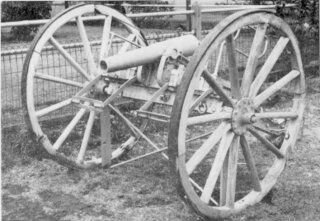
7 pr RML on Field Carriage -
this gun is now at Kokstad.
The gun illustrated is now in Kokstad. It has an arc and pinion elevation system.
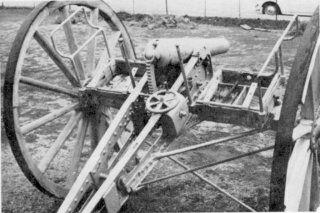
7 pr RML on Field Carriage -
elevation is by arc and pinion;
the trunnions are at the centre of the arc.
Most guns today use this system.
2.5 IN RML ON FIELD CARRIAGE:
Specifications.. .. .. Similar to the 'Screw Gun'
The 'Screw Gun' was also mounted on a Field carriage for greater mobility. It was issued to locally raised units. With the Natal Field Battery it was present at Elandslaagte, and with the Diamond Fields Artillery, was besieged in Kimberley.

2,5 inch RML on Field Carriage -
probably a gun of the Natal Field Battery in action in Natal.
The man on the left is about to fire the gun by 'chopping' down
on the firing lanyard. Elevation is by elevating screw;
note the drag shoes method of controlling recoil.
This gun was often described as a 7 pr. When the 'Screw Gun' first appeared, it was known as a 7 pr, but there was then confusion between this and the original 7 pr. The two guns did not use the same ammunition, and so to clarify matters, the new gun was designated the 2.5 in RML. This may explain why both designations are used in describing the armament of the two units mentioned above.
There are references in contemporary records to 'Kaffrarian carriages' and 'Randle (or Randall) carriages', in connection with 7 prs. These may be the carriages of the 7 pr and 2.5 in RML, but if so, it is not known which is which.
There are two 2.5 in RMLs on Field carriages at Fort Klapperkop Military Museum, and one on a Mountain carriage. The three guns are in very good condition.

2,5 inch RML on Field Carriage -
this gun is at Fort Klapperkop.
It is the same "Screw Gun" given
greater mobility than the Mountain version.
9 PR RML 8 CWT:
| Calibre | 3 in |
| Weight of gun | 8 cwt |
| Ammunition | Common, Shrapnel and Case |
| Weight of shell | 9 lbs approx. |
| Range: Common | 3,500 yds |
| Range: Shrapnel | 2,910 yds |
| Range: Case | Effective up to about 350 yds |
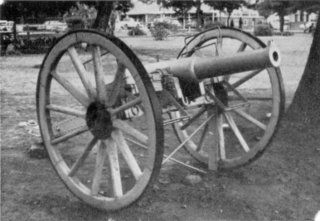
9 pr RML 8 cwt -
this gun is now at Kokstad.
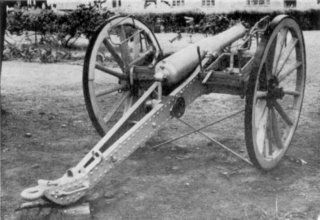
9 pr RML 8 cwt -
the axletree seats on this gun
have deteriorated over the years.
Elevation is by elevating screw.
REFERENCES
Times History of the War in South Africa (in particular Volume
VI, Part II, Chapter VIII, 'The Armament and Employment of the Artillery').
History of the Royal Artillery 1860-1914 - Callwell and Headlam.
Proceedings of the Royal Artillery Institution (Volumes XXVI to
XXIX).
The History of Indian Mountain Artillery - Graham.
The Elements of Field Artillery (1877) - Knollys.
Text Books of Gun Carriages and Gun Mountings 1924.
S.A. Military History Journal (in particular Volume 1, No.4,
'The Elswick Guns', by Maj. L. A. Crook).
The Story of the Gun - Wilson.
With the Naval Brigade in Natal - Burne.
Navy and Army Illustrated.
The Siege of Kimberley 1899-1900.
British Smooth-Bore Artillery - Hughes.
Artillery: Its Origin, Heyday and Decline - Hogg.
Note. - Where possible, gun specifications and details of performance have been taken from the Times History.
Return to Journal Index OR Society's Home page
South African Military History Society / scribe@samilitaryhistory.org